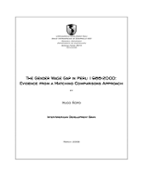The Gender Wage Gap in Peru 1986-2000: Evidence from a Matching Comparisons Approach
Date
Mar 2009
Applying the methodology developed in Ñopo (2004), this paper analyzes the evolution of the gender wage gap in Peru from 1986 to 2000. This methodology has two advantages. First, it recognizes that the supports of observable characteristics distributions differ substantially. Second, it provides deeper insights regarding the distribution of the unexplained gender differences in earnings. For the period under analysis, males earn on average 45 percent more than females. This wage gap is composed of three additive elements: 11 percent differences in supports, 6 percent differences in distributions of individual characteristics and 28 percent unexplainable differences. About half of these unexplainable differences occur in the highest quintile of the wage distribution.



